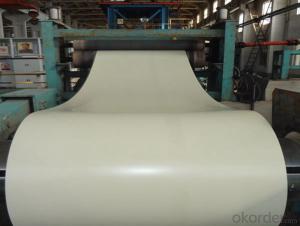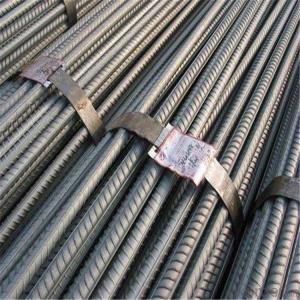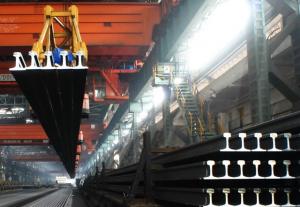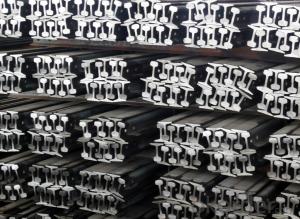Steel Light Rail with High Quality for Warehouse ,Minas, Structures
- Loading Port:
- China main port
- Payment Terms:
- TT or LC
- Min Order Qty:
- 25 m.t.
- Supply Capability:
- 100000 m.t./month
OKorder Service Pledge
OKorder Financial Service
You Might Also Like
Product Description of Steel Light Rail with High Quality for Warehouse ,Minas, Structures:
Alloy No | Grade | Element(%) | ||||
C | Mn | S | P | Si | ||
Q235 | B | 0.12—0.20 | 0.3—0.7 | ≤0.045 | ≤0.045 | ≤0.3 |
Sizes: 38kg, 43kg, 45kg, 50kg, 60kg.
Production Standard: GB2585-81, DIN, AREMA, JIS, BS, UIC, etc.
Material: 50MN, U71MN, 900A, 110A, etc.
Length: 6m-25m according to the requriements of the clients
Usages of Steel Light Rail with High Quality for Warehouse ,Minas, Structures:
Light rail is mainly used in forest region, mines, factories and construction sites laid of the place such as temporary transport line and light motorcycles with line. Be widely used for railway, subway, transportation track, express, curve way, tunnel way and so on.
Packaging & Delivery of Steel Light Rail with High Quality for Warehouse ,Minas, Structures:
1. Packing: it is nude packed in bundles by steel wire rod
2. Bundle weight: not more than 3.5MT for bulk vessel; less than 3 MT for container load
3. Marks:
Color marking: There will be color marking on both end of the bundle for the cargo delivered by bulk vessel. That makes it easily to distinguish at the destination port.
Tag mark: there will be tag mark tied up on the bundles. The information usually including supplier logo and name, product name, made in China, shipping marks and other information request by the customer.
If loading by container the marking is not needed, but we will prepare it as customer request.
4. Transportation: the goods are delivered by truck from mill to loading port, the maximum quantity can be loaded is around 40MTs by each truck. If the order quantity cannot reach the full truck loaded, the transportation cost per ton will be little higher than full load.
5. Delivered by container or bulk vessel
6. Delivery Time: All the Hot Rolled Steel Rail will be transpoted at the port of Tianjin, China within 30 days after receiving the advance payment by T/T or the orginal L/C at sight.
Inspection of Steel Light Rail with High Quality for Warehouse ,Minas, Structures:
We will send the MTC of the factory to the clients dirrectly which contain the anlisis of the heat, chemiqul composition, phisical characteristicas, etc.
And our inspectors will arrive at the factory to meke the inspection of the size, length, weight and quantity before the transportation from the factory.
FAQ:
Q1: How soon can we receive the product after purchase?
A1: Within three days of placing an order, we will begin production. The specific shipping date is dependent upon international and government factors, but is typically 7 to 10 workdays.
Q2: How do we guarantee the quality of our products?
A2: We have established an advanced quality management system which conducts strict quality tests at every step, from raw materials to the final product. At the same time, we provide extensive follow-up service assurances as required.
Q3: Why buy Materials & Equipment from OKorder.com?
A3: All products offered by OKorder.com are carefully selected from China's most reliable manufacturing enterprises. Through its ISO certifications, OKorder.com adheres to the highest standards and a commitment to supply chain safety and customer satisfaction.
Images:
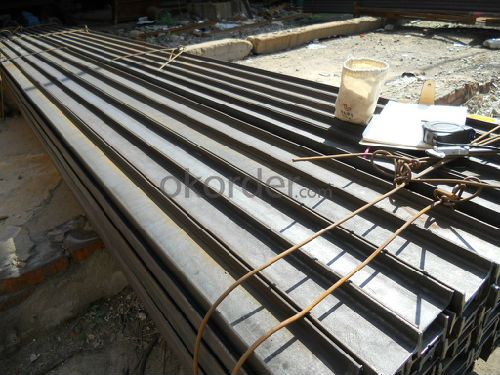
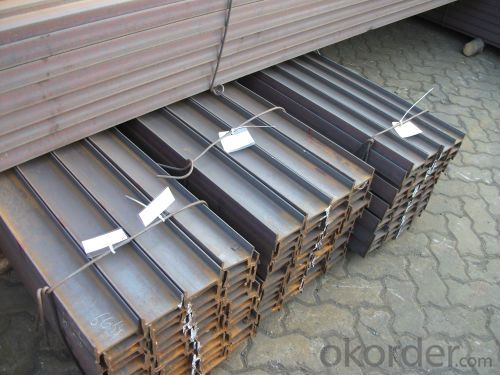
- Q:Can steel rails be used in curved elevated railway structures?
- Curved elevated railway structures can indeed make use of steel rails. Due to its strength and durability, steel is a popular choice for railway construction. Its ability to withstand wear and tear, coupled with its versatility for shaping and bending, makes it an ideal material for accommodating curves in elevated railway structures. This, in turn, facilitates efficient and safe train operations. Furthermore, steel rails offer stability and support to the railway system, ensuring seamless train movement around curves. However, it is crucial to design and engineer the curved elevated railway structure correctly to guarantee that the steel rails can withstand the forces and stresses associated with the curvature.
- Q:How do steel rails contribute to the safety of railway operations?
- Steel rails contribute to the safety of railway operations in multiple ways. Firstly, they provide a stable and sturdy track foundation, ensuring the smooth movement of trains. This reduces the risk of derailments and accidents caused by an unstable track. Additionally, steel rails have high tensile strength and can withstand heavy loads, preventing them from bending or breaking under the weight of the trains. This durability allows for safer and more reliable train operations. Moreover, steel rails have excellent resistance to wear and tear, reducing the need for frequent maintenance and minimizing the chances of track failures or disruptions. Overall, the use of steel rails helps to maintain the integrity and safety of railway operations.
- Q:How do steel rails contribute to the overall reliability of rail transportation?
- Steel rails contribute to the overall reliability of rail transportation in several ways. Firstly, steel is a durable material that can withstand heavy loads and constant use, ensuring that the rails remain intact and functional for long periods of time. This durability reduces the need for frequent repairs or replacements, leading to a more reliable and efficient rail network. Additionally, steel rails have high resistance to wear and tear, reducing the chances of accidents or derailments caused by rail failure. Furthermore, steel rails provide a smooth and stable surface for trains to travel on, minimizing vibrations and ensuring a comfortable and safe ride for passengers and cargo. Overall, the use of steel rails enhances the reliability and safety of rail transportation systems.
- Q:How do steel rails handle vibrations and shocks?
- Steel rails are designed to handle vibrations and shocks effectively due to their inherent strength and resilience. The dense and rigid structure of steel enables it to absorb and dissipate the energy generated by vibrations and shocks, thereby minimizing any significant impact on the rails. Additionally, steel rails are often reinforced and installed with appropriate fastening systems to further enhance their ability to withstand and dampen vibrations and shocks.
- Q:Can steel rails be used in areas with high moisture or humidity?
- Yes, steel rails can be used in areas with high moisture or humidity. Steel is known for its strength and durability, making it a popular choice for railway tracks. However, in areas with high moisture or humidity, there is a higher risk of corrosion and rusting. To mitigate this risk, steel rails are often coated with protective layers, such as zinc or paint, to prevent direct exposure to moisture. Additionally, regular maintenance and inspections are crucial to identify and address any signs of corrosion or rust. By implementing these measures, steel rails can effectively withstand high moisture or humidity and maintain their structural integrity for a prolonged period.
- Q:What are the factors considered in determining the appropriate steel rail corrosion resistance for a railway line?
- The factors considered in determining the appropriate steel rail corrosion resistance for a railway line include the environmental conditions in which the railway line is located, such as humidity, temperature, and exposure to corrosive agents like salts or chemicals. Other factors include the type of traffic and load on the railway line, the frequency of maintenance and inspection, the rail design and material composition, and the overall lifespan and cost-effectiveness of the corrosion protection measures.
- Q:What is the maximum speed that steel rails can handle?
- The maximum speed that steel rails can handle depends on various factors such as the quality of the rail material, maintenance practices, and the design of the track. Generally, steel rails can handle speeds ranging from 80 to 125 miles per hour (130 to 200 kilometers per hour) for conventional rail lines. However, for high-speed rail systems, specially designed tracks and rails can support speeds of up to 186 miles per hour (300 kilometers per hour) or even higher.
- Q:How are steel rails affected by changes in track alignment?
- Steel rails can be affected by changes in track alignment, which can lead to various consequences. Initially, sudden shifts or misalignments in the track can exert excessive stress on the steel rails, causing them to wear down more quickly. This can result in cracks, breaks, or deformations in the rails, which undermines their structural integrity. Furthermore, alterations in track alignment can also impact how forces are distributed on the steel rails. When the track alignment is not smooth, the weight of the train and the forces generated during its movement may not be evenly spread across the rails. Consequently, certain sections of the rails may bear more weight, leading to accelerated wear and the possibility of rail failure. Additionally, changes in track alignment can influence the overall stability and comfort of train rides. Misaligned tracks can produce excessive vibrations and impacts, which can cause discomfort for passengers and harm to the rolling stock. This can result in higher maintenance costs and decreased operational efficiency. Moreover, changes in track alignment can affect the safety of train operations. Misaligned tracks can heighten the risk of derailments, especially when trains are traveling at higher speeds. Proper track alignment is crucial for ensuring the safe and efficient movement of trains, and any deviations from the desired alignment can compromise the overall safety of the rail system. Overall, changes in track alignment can have negative effects on steel rails, including increased wear and tear, compromised structural integrity, uneven distribution of forces, reduced stability and comfort, and potential safety hazards. Therefore, regularly monitoring and maintaining track alignment is essential to guarantee the longevity, efficiency, and safety of steel rails in railway systems.
- Q:What are the common causes of rail misalignment in steel rails?
- There are several common causes of rail misalignment in steel rails. One of the main causes is improper installation or maintenance of the rail tracks. If the tracks are not installed correctly or are not properly maintained, they can shift or become misaligned over time. This can happen if the fasteners are not tightened properly, if the ballast beneath the tracks becomes displaced, or if the rails are not regularly inspected and repaired. Another common cause is the impact of heavy loads or excessive traffic on the rails. When a train or other heavy load passes over the tracks, it can create a significant amount of force that can cause the rails to shift or become misaligned. This is especially true if the tracks are not designed to handle the weight or volume of traffic that they are being subjected to. Environmental factors can also contribute to rail misalignment. Changes in temperature, for example, can cause the rails to expand or contract, which can lead to misalignment. Additionally, extreme weather conditions such as heavy rain or flooding can cause the ballast beneath the tracks to erode or become unstable, which can result in rail misalignment. Lastly, wear and tear over time can also cause rail misalignment. As the rails age, they can become worn down or damaged, which can lead to misalignment. This can be exacerbated if the tracks are not regularly inspected, maintained, and repaired. Overall, proper installation, regular maintenance, and appropriate design are crucial in preventing rail misalignment in steel rails. By addressing these common causes, rail operators can ensure the safety and efficiency of their railway systems.
- Q:How do steel rails handle heavy loads and freight trains?
- Steel rails are specifically designed to handle heavy loads and freight trains efficiently and safely. They are made from high-quality steel, which provides exceptional strength and durability. The rails are laid on a solid foundation, allowing them to distribute the weight of the trains evenly and prevent excessive wear or damage. Additionally, the shape of the rails, with a wide base and a slightly curved top, helps to minimize stress and maintain stability, even under heavy loads and frequent train movements. Overall, steel rails are engineered to withstand the immense pressure and weight of freight trains, ensuring reliable and smooth transportation of goods.
1. Manufacturer Overview |
|
|---|---|
| Location | |
| Year Established | |
| Annual Output Value | |
| Main Markets | |
| Company Certifications | |
2. Manufacturer Certificates |
|
|---|---|
| a) Certification Name | |
| Range | |
| Reference | |
| Validity Period | |
3. Manufacturer Capability |
|
|---|---|
| a)Trade Capacity | |
| Nearest Port | |
| Export Percentage | |
| No.of Employees in Trade Department | |
| Language Spoken: | |
| b)Factory Information | |
| Factory Size: | |
| No. of Production Lines | |
| Contract Manufacturing | |
| Product Price Range | |
Send your message to us
Steel Light Rail with High Quality for Warehouse ,Minas, Structures
- Loading Port:
- China main port
- Payment Terms:
- TT or LC
- Min Order Qty:
- 25 m.t.
- Supply Capability:
- 100000 m.t./month
OKorder Service Pledge
OKorder Financial Service
Similar products
New products
Hot products
Hot Searches
Related keywords









